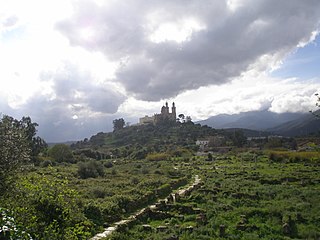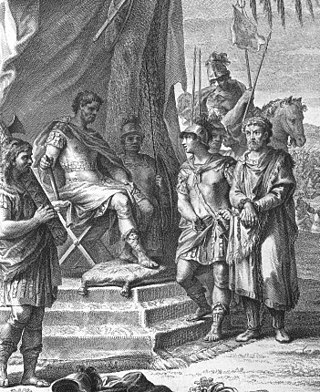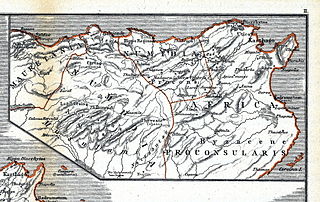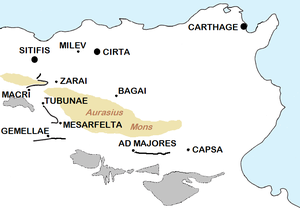
Numidia was the ancient kingdom of the Numidians in northwest Africa, initially comprising the territory that now makes up Algeria, but later expanding across what is today known as Tunisia and Libya. The polity was originally divided between the Massylii in the east and the Masaesyli in the west. During the Second Punic War, Masinissa, king of the Massylii, defeated Syphax of the Masaesyli to unify Numidia into the first Berber state in present-day Algeria. The kingdom began as a sovereign state and later alternated between being a Roman province and a Roman client state.

Hippo Regius is the ancient name of the modern city of Annaba, Algeria. It historically served as an important city for the Phoenicians, Berbers, Romans, and Vandals. Hippo was the capital city of the Vandal Kingdom from 435 to 439 AD. until it was shifted to Carthage following the Vandal capture of Carthage (439).

Jugurtha or Jugurthen was a king of Numidia. When the Numidian king Micipsa, who had adopted Jugurtha, died in 118 BC, Jugurtha and his two adoptive brothers, Hiempsal and Adherbal, succeeded him. Jugurtha arranged to have Hiempsal killed and, after a civil war, defeated and killed Adherbal in 112 BC.

The history of North Africa during the period of classical antiquity can be divided roughly into the history of Egypt in the east, the history of ancient Libya in the middle and the history of Numidia and Mauretania in the West.

Constantine, also spelled Qacentina or Kasantina, is the capital of Constantine Province in northeastern Algeria. During Roman times it was called Cirta and was renamed "Constantina" in honour of Emperor Constantine the Great. Located somewhat inland, Constantine is about 80 kilometres from the Mediterranean coast, on the banks of the Rhumel River.

Lambaesis (Lambæsis), Lambaisis or Lambaesa, is a Roman archaeological site in Algeria, 11 km (7 mi) southeast of Batna and 27 km (17 mi) west of Timgad, located next to the modern village of Tazoult. The former bishopric is also a Latin Catholic titular bishopric.

Mila is a city in the northeast of Algeria and the capital of Mila Province. In antiquity, it was known as Milevum or Miraeon, Μιραίον and was situated in the Roman province of Numidia.

Milevum was a Roman–Berber city in the Roman province of Numidia. It was located in present-day Mila in eastern Algeria.
For nearly 250 years, Berber kings of the 'House of Masinissa' ruled in Numidia in modern day Algeria, and later in adjacent regions, first as sovereigns allied with Rome and then eventually as Roman clients. This period commenced by the Roman Army, assisted by Berber cavalry led by Masinissa at the Battle of Zama in 202 BC, and it lasted until the year 40 AD, during the reign of the Roman Emperor Gaius, also known as Caligula.

Madauros was a Roman-Berber city and a former diocese of the Catholic Church in the old state of Numidia, in present-day Algeria.

Igilgili was a Berber town and a Phoenician, Carthaginian, and Roman colony in located in present-day Jijel, Algeria.

Tiddis was a Roman city that depended on Cirta and a bishopric as "Tiddi", which remains a Latin Catholic titular see.

Civitas Popthensis was an ancient Roman-Berber city located in the present-day Henchir Kssiba area in the municipality of Ouled Moumen in Souk Ahras Province, Algeria. The word "civitas" is derived from the Latin civis ("city"), meaning that the city was a politically autonomous city-state.

Roman colonies in North Africa are the cities—populated by Roman citizens—created in North Africa by the Roman Empire, mainly in the period between the reigns of Augustus and Trajan.
Arabio was the last independent Numidian king, ruling the western region between 44 and 40 BC. According to Appian, he was a son of Masinissa II and probable grandson of Gauda, who had divided Numidia between his sons in 88 BC. He was of Massylian origin.

Numidia was a Roman province on the North African coast, comprising roughly the territory of north-east Algeria.
The siege of Cirta was fought between the rival Numidian kings Adherbal and Jugurtha in 113 BC. They were contesting the throne of Numidia after the death of King Micipsa. Jugurtha invaded Adherbal's territory, defeated him and besieged him in his capital Cirta. Two Roman deputations attempted to negotiate a settlement, but Jugurtha ignored them. When the city surrendered he tortured Adherbal to death and executed all who had bourne arms against him, including numerous Romans. This last action was to spark the outbreak of the Jugurthine War between Rome and Numidia.

Masinissa, also spelled Massinissa, Massena and Massan, was an ancient Numidian king best known for leading a federation of Massylii Berber tribes during the Second Punic War, ultimately uniting them into a kingdom that became a major regional power in North Africa. Much of what is known about Masinissa comes from the Livy's History of Rome, and to a lesser extent Cicero's Scipio's Dream. As the son of a Numidian chieftain allied to Carthage, he fought against the Romans in the Second Punic War, but later switched sides upon concluding that Rome would prevail. With the support of his erstwhile enemy, he united the eastern and western Numidian tribes and founded the Kingdom of Numidia. As a Roman ally, Masinissa took part in the decisive Battle of Zama in 202 BC that effectively ended the war in Carthage's defeat; he also allowed his wife Sophonisba, a famed Carthaginian noblewoman who had influenced Numidian affairs to Carthage's benefit, to poison herself in lieu of being paraded in a triumph in Rome.
The Battle of Hippo Regius was a naval encounter during Caesar's Civil War which occurred off the coast of the African city of Hippo Regius in 46 BC. Metellus Scipio and a number of influential senators from the Optimate faction were fleeing the disastrous Battle of Thapsus when their fleet was intercepted and destroyed by Publius Sittius, a mercenary commander in the employ of the Mauretanian king Bogud, an ally of Gaius Julius Caesar's. Scipio committed suicide and all of the other senators were killed during the battle.



















